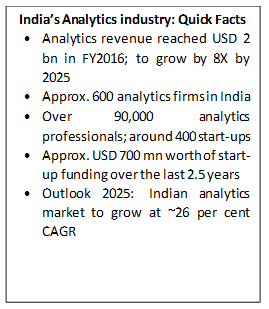With a focus on driving business outcomes and customer experience by way of leveraging analytical services and products, the National Association of Software and Services Companies [NASSCOM] inaugurated the fourth edition of its Big Data & Analytics Summit 2016 in Hyderabad. Growing at 8 times the current levels, the analytics industry is expected to reach USD 16 billion from the current level of USD 2 billion.
Over 600+ analytical firms in India, out of which approximately 400 are start-ups, are positioning India as an emerging hub for analytics solutions for industries across the globe. The big data and analytics industry is witnessing a rapid growth driven by increased demand for cloud-based [SaaS] and predictive analytics solutions by industries such as BFSI, Retail, Telecom and Healthcare.

Exponential growth of the number of devices, paired with the deluge of unstructured data – in the form of social media interactions, video or text – has ensured that. Being able to tap into this data and act on the insights, is a key differentiator between digital attackers and the laggards. The key to the future in leveraging big data technologies lies in the ability to harness its use in addressing complex problems.
 This rapid rise of analytics is reflecting in job creation across verticals and functions with skills from analytics, business and technology. With over 90,000 analytics professionals in India across HR, marketing, risk & security, healthcare, and verticals like retail and finance, the industry is witnessing the emergence of specialised roles like data architect,data strategist, data visualization analyst and change manager etc.
This rapid rise of analytics is reflecting in job creation across verticals and functions with skills from analytics, business and technology. With over 90,000 analytics professionals in India across HR, marketing, risk & security, healthcare, and verticals like retail and finance, the industry is witnessing the emergence of specialised roles like data architect,data strategist, data visualization analyst and change manager etc.
Speaking at the occasion, KS Viswanathan, VP, NASSCOM mentioned
India is today amongst the top 10 destination for analytics and our aspiration is to be amongst the top 3 in the world by 2025. NASSCOM is partnering with its members to build a multi-pronged approach that encompasses-skill development, thought leadership, products and platforms to realise this vision.
Artificial Intelligence & Deep learning algorithms have advanced rapidly to enable the development of machines that can now do tasks that require deep expertise and skill. The best companies today are realizing the power of Artificial Intelligence [AI] and investing in utilizing these algorithms in all aspects of their business. Industry will start exploring artificial intelligence and deep learning algorithms for analytics and radically change product delivery to create new markets and engagement models.
BVR Mohan Reddy, Former Chairman, NASSCOM & Founder and Executive Chairman at Cyient, added
Multiple opportunities are emerging across business verticals and are opening up large opportunities for companies in data, infrastructure, software and analytics. Of special importance is emergence of custom visualisation software, development of algorithms for predictive analytics, cloud based services and Machine to Machine Learning. The growth trajectory shows that India will soon emerge as big data and analytics hub of the world.
About NASSCOM
NASSCOM is the premier trade body and the chamber of commerce of the IT-BPM industry in India. NASSCOM is a global trade body with more than 1800 members, which includes both Indian and multinational companies that have a presence in India. NASSCOM’s member and associate member companies are broadly in the business of software development, software services, software products, consulting services, BPM, e-commerce and web services, engineering services and animation and gaming. NASSCOM’s membership base constitutes over 95% of the industry revenues in India and employs about 3.5 million professionals.




